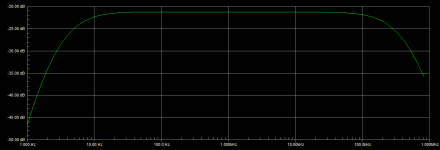750 or 75uS?????
There is a thing that I don't understand.
The RIAA poles are 3180uS, (50Hz) , 318uS ( 500Hz) and 75uS ( 2212 Hz). The passiv filter make this constants due serial RC networks.
Well , the RC R5 (50K) and C3 (15n75) in theory must be 75uS, but a see usually a cap ten times biger and the constant is 750us (221Hz) .This pole is behind the precedent pole 318uS. I think this cap value is too much higher. I see " this high cap value" in many schemas and calculate progs do this value.
I try lower this cap ( ten times) in my passiv RIAA and now it sounds fantastic, more better.
Is an chain-error from copy/paste the info or what really happens?
750uS or 75uS ????
Cheers
There is a thing that I don't understand.
The RIAA poles are 3180uS, (50Hz) , 318uS ( 500Hz) and 75uS ( 2212 Hz). The passiv filter make this constants due serial RC networks.
Well , the RC R5 (50K) and C3 (15n75) in theory must be 75uS, but a see usually a cap ten times biger and the constant is 750us (221Hz) .This pole is behind the precedent pole 318uS. I think this cap value is too much higher. I see " this high cap value" in many schemas and calculate progs do this value.
I try lower this cap ( ten times) in my passiv RIAA and now it sounds fantastic, more better.
Is an chain-error from copy/paste the info or what really happens?
750uS or 75uS ????
Cheers
There is a thing that I don't understand.
The RIAA poles are 3180uS, (50Hz) , 318uS ( 500Hz) and 75uS ( 2212 Hz). The passiv filter make this constants due serial RC networks.
Well , the RC R5 (50K) and C3 (15n75) in theory must be 75uS, but a see usually a cap ten times biger and the constant is 750us (221Hz) .This pole is behind the precedent pole 318uS. I think this cap value is too much higher. I see " this high cap value" in many schemas and calculate progs do this value.
I try lower this cap ( ten times) in my passiv RIAA and now it sounds fantastic, more better.
Is an chain-error from copy/paste the info or what really happens?
750uS or 75uS ????
Cheers
75uS is the correct value, but some calculations use 50us - see online RIAA calculators.
RIAA was established in 1957 and before this time nearly every recording company used it's own curve (especially in the mono recording times). As well you should take note that some recording companies use this own curves untill the mid 1970s as well.
Its the opposite, decrease that cap.
Yeah, I use the minimal capacity of the grid miller effect from the second amplifier section (a inappropiate 12ax7 clone again) like a principal capacity for 75uS time constant and it works at my case..... very well!!!
Cheers
Impedance is lower at the front at least in this design. Its not keeping the same RC time then, the coupling cap will need get bigger. So there is a physical construction advantage to C4 as it is located now. Smaller value brings smaller price too and more access to dielectrics like Teflon etc.
It surely rolled off your under 100HZ bass more. Maybe 2dB by 30HZ if you had 100nF C4. Your room modes with the speakers can easily be a roller coaster of many dB at the nodal region anyway so its can be sounding weirder but not weaker in average. Headphones can be better tool for evaluating bass.
- Home
- Source & Line
- Analogue Source
- Valve Itch phono
